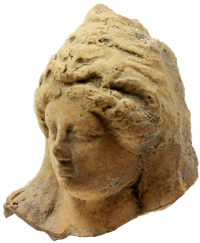Head of an Artemis italica with lion skin cap
Description: The hair parts above the forehead and curls over the temples and ears. The roundish-oval face is dominated by the large, straight nose. Smooth cheeks taper decidedly against the chin separated from the lower lip by a deep notch. An approach to the double chin is clear. The full, curved lips are firmly closed. Wide, ribbon-like lids enclose the narrow, wide-set eyes. Above the slightly arched orbits the brows run almost horizontally.
The head is covered with a lion-skin cap consisting of the upper jaw with the nose, the small round eyes and two symmetrical arches of curled fur. The paws fall on the shoulders.
Commentary: The type of Artemis italica with a lion-skin cap[1], known in Greater Greece and also popular in Sicily, is centred in the region of Tarent-Lucania[2]. In contrast to the Artemis Bendis adorned with the Thracian alopekis, a fox fur cap, the goddess in her sub-Italian manifestation wears a pointed cap with a lion mask pulled over it[3]. Nevertheless, the inaccurate designation "Bendis" continues to be handed down[4]. The association of the Italic Artemis with the lion probably reflects Taranto's close relationship with his mother city Sparta, where the goddess is worshipped in her capacity as the ruler of untamed nature (potnia theron)[5].
The dimensions of the head T I-14 suggest an original height of the figure of 50-60 cm. In a narrower sense, the head belongs to a type with forehead hair protruding from under the lion's cap[6].
The particular width of the eye-cheekbone section and the large distance between the eyes are indications that it was made in a Western Greek workshop.
Despite the open back, the head gives a rounded impression. The plump cheeks, the pit between the lower lip and chin as well as the tendency towards a double chin and the full hair bulging at the sides are stylistic features of the 1st half of the 4th century BC[7].
Determination: 1st half of the 4th century BC, from Taranto or Herakleia/Lucania.
 |
 |
 |
|---|
[1] C. Letta, Piccola coroplastica metapontina nel Museo Archeologico Provinciale di Potenza (Neapel 1971) 121-123 pl. 24, 4.
[2] Taranto: C. Iacobone, Le stipi votive di Taranto (Rom 1988) 21-23 pl. 11b; W. Schürmann, Katalog der antiken Terrakotten im Badischen Landesmuseum Karlsruhe (Göteborg 1989) 54-56 no. 140-147 pl. 28; Herakleia: B. Neutsch, Archäologische Forschungen in Lukanien II. Herakleiastudien, RM Ergh. 11 (Heidelberg 1967) 167-169 pl. 28; Metapont: U. Anzenberger, Artemis-Bendis. Kult und Votive in Griechenland und der Magna Graecia (Diplomarbeit Leopold- Franzens- Universität Innsbruck 2001) 125; D. Adamesteanu – D. Mertens – F. d’Andria, Metaponto I, NSc Suppl. 29, 1975 (Rom 1980) 94 fig. 84 a. p. 145 fig. 150 a.
[3] W. Schürmann, Katalog der antiken Terrakotten im Badischen Landesmuseum Karlsruhe (Göteborg 1989) 54 f. no. 140; C. Letta, Piccola coroplastica metapontina nel Museo Archeologico Provinciale di Potenza (Neapel 1971) 122 incl. note 376; LIMC II (1984) 690-692 no. 921. 925a. 928. 934 pl. 515 f. s. v. a. Artemis (L. Kahil).
[4] C.W. Lunsingh Scheurleer, Die Göttin Bendis in Tarent, AA 1932, 314-334; M. Bonghi Jovino, Documenti di coroplastica italiota, siceliota ed etrusco-laziale nel Museo Civico di Legnano (Florenz 1972) 84-98 pl. 25/26; B. Neutsch, Archäologische Forschungen in Lukanien II. Herakleiastudien, RM Ergh. 11 (Heidelberg 1967) 167 pl. 28, 1-3; R. Miller Ammerman, The Religious Context of Hellenistic Terracotta Figurines, in: J. P. Uhlenbrock, The Coroplast’s Art. Greek Terracottas of the Hellenistic World (New York 1990) 40 fig. 28; B. Otto, Il santuario sorgivo di Siris-Herakleia nell’odierno Comune di Policoro, in: M. L. Nava – M. Osanna (eds.), Lo spazio del rito. Santuari e culti in Italia Meridionale tra indigeni e greci. Atti delle Giornate di Studio, Matera 28 e 29 Giugno 2002 (Bari 2005) 16:
[5] K. Schauenburg, Bendis in Unteritalien? JdI 89, 1974, 181 note 138a; P. Orlandini, Tipologia e cronologia del materiale archeologico di Gela I, ArchCl 9, 1957, 54 f. pl. 14; U. Anzenberger, Artemis-Bendis. Kult und Votive in Griechenland und der Magna Graecia (Diplomarbeit Leopold- Franzens- Universität Innsbruck 2001) 122.
[6] M. Bonghi Jovino, Documenti di coroplastica italiota, siceliota ed etrusco-laziale nel Museo Civico di Legnano (Florenz 1972) 53f. no. 89. 91 pl. 25; F. Winter, Die Typen der figürlichen Terrakotten. Die antiken Terrakotten, Band III, 2 (Berlin 1903) 162, 5. B. Neutsch, Archäologische Forschungen in Lukanien II. Herakleiastudien, RM Ergh. 11 (Heidelberg 1967) 239 pl. 28, 1. 3; C. Iacobone, Le stipi votive di Taranto (Rom 1988) 30 f. pls. 24 a-c; E. Lippolis, Arte e artigianato in Magna Grecia (Neapel 1996) 202 no. 148.
[7] Bonghi Jovino, ibid. 49-50 no. 77 and 80 pl. 23; R.A. Higgins, Catalogue of the Terracottas in the Department of Greek and Roman Antiquities British Museum (London 1954) 360 no. 1324 pl. 181; S. Mollard-Besques, Catalogue raisonné des figurines et reliefs en terre-cuite grecs et romains I (Paris 1954) 127 no. C 275 pl. 90; E. Langlotz, Die Kunst der Westgriechen (München 1963) 88 f. fig. 132 and pl. 12.

